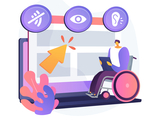October Disability Awareness Month Fosters Inclusion in Higher Education
Focus on digital accessibility ensures access, equity to all
In 2019-20, approximately 21 percent of undergraduate students and 11 percent of post baccalaureate students reported having a disability (National Center for Education Statistics, Fast Facts, 2023). Disability Awareness Month offers an opportunity to increase awareness about the variety of disabilities students may experience and help break down misconceptions.
Inclusive Experiences for All
Disability awareness includes addressing physical environments and improving accessibility in buildings, classrooms, and public spaces to ensure all individuals can navigate and participate fully. This might involve installing ramps, widening doorways, adding signage, or improving lighting. The Office of Accessibility & Disability raises awareness about the lived experiences of people with disabilities and highlights services for faculty, staff, and students at UMBC.
Instructors play an important role in recognizing the diverse needs of students with disabilities while striving to promote equity and access for all. This includes creating inclusive learning experiences for students with disabilities and might involve providing assistive technologies, flexible teaching methods, or individualized support plans.
Creating more accessible courses also requires consideration of diverse learning styles and approaches that result in engaging learning for all students. Strategies grounded in Universal Design for Learning principles can leverage technology in ways that help all students succeed. Key practices that support accessible course design include the following.
Universal Design for Learning
One of the most impactful ways instructors can support students is by using Universal Design for Learning (UDL) guidelines, a framework that aims to provide multiple means of engagement, representation, and expression for learners. UDL benefits all students, not just those with disabilities, because it offers flexible ways learners can access content and demonstrate knowledge.
UDL is a key practice that supports accessible course design. Instructors can get started in any of the following ways:
- Review UDL guidelines that support offering multiple means of representation to learners by employing various formats such as text, audio, and visual materials to accommodate diverse learning preferences.
- Foster engagement by incorporating interactive elements, discussions, or hands-on activities that cater to visual, auditory, and kinesthetic learners.
- Ask key questions about learner engagement, representation, action and expression when designing a module or unit in your course.
- Implement UDL incrementally and intentionally. Refer to scholarly works like Behling & Tobin (2018) for guidance. They encourage faculty to think of UDL as “plus-one thinking about the interactions in your course” (p. 134). Is there just one more way you can help students stay on task, give them information, or demonstrate skills?
QM’s Accessibility and Usability Resource Site
- Register for free access to Quality Matters’ Accessibility and Usability Resource Site (AURS), the go-to resource for educators to address key accessibility and usability concerns in course design. Log into MyQM, or create your QM account. After successfully logging in, use the side navigation menu to select “Workshop-Register” and self-enroll into AURS (last item on the workshop list).
- Explore AURS resources, videos, and best practices on topics like UDL, alternative text, captions, hyperlinks, accessible MS Office products, readability, accessible PDFs, accessible course design, and inclusive teaching practices.
Anthology Ally for Remediation, Alt Text
- Explore accessibility tools and built-in features that allow you to cater to students with different abilities and meet recently updated federal requirements for digital accessibility compliance. For example, Ally is a tool available in Blackboard Ultra that improves the accessibility of courses by scanning course content, generating an Accessibility Report, and providing tools to fix accessibility issues.
- Use Ally's Instructor Feedback Panel to preview content and prioritize remediation.
- Consider Ally's powerful alternative format options and let students know they can download content in multiple formats that give them choices in how they watch, read, or listen.
Attending disability awareness workshops or collaborating with the Office of Student Disability Services (SDS) can provide instructors with the tools to accommodate the needs of students with disabilities in the classroom.
Save the dates!
Join Instructional Technology for upcoming digital accessibility events:
- October 3 - October 3rd is Fix Your Blackboard Content Day: Create Inclusive Digital Materials Using Ally - Session #1, 10 a.m.
- October 3 - October 3rd is Fix Your Blackboard Content Day: Create Inclusive Digital Materials Using Ally - Session #2, 2 p.m.
- October 15 - VoiceThread Accessibility and Universal Design for Learning (Hosted by VoiceThread), 1 p.m.
- October 16 - UDL Guidelines 3.0: What’s New and Why it Matters (Hosted by CourseArc), 2 p.m.
- October 17 - Create Accessible Documents, 12 p.m.
- October 25 - Inclusion by Design Virtual Conference: Building Bridges to Accessibility to All (Virtual event sponsored by Montgomery College)
- October 29 - Create Accessible Presentations, 12 p.m.
- November 12 - Create Accessible Instructional Videos, 12 p.m.
References
- Behling, K. & Tobin, T. J. (2018). Reach everyone, teach everyone: Universal Design for Learning in higher education. Morgantown: West Virginia University Press. https://wvupressonline.com/node/757.
- CAST (2018). Universal Design for Learning Guidelines version 2.2. Retrieved from http://udlguidelines.cast.org
- National Center for Education Statistics. (2023, TBA). Table 311.10. Number and percentage distribution of students enrolled in postsecondary institutions, by level, disability status, and selected student characteristics: Academic year 2019–20 [Data table]. In Digest of education statistics. U.S. Department of Education, Institute of Education Sciences. Retrieved December 5, 2023, from https://nces.ed.gov/programs/digest/d22/tables/dt22_311.10.asp.
(Image designed by vectorjuice on Freepik)
Posted: October 2, 2024, 9:47 AM
